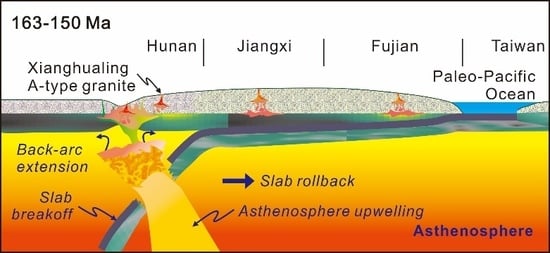Petrogenesis of Low Sr and High Yb A-Type Granitoids in the Xianghualing Sn Polymetallic Deposit, South China: Constrains from Geochronology and Sr–Nd–Pb–Hf Isotopes
Abstract
1. Introduction
2. Geological Background
3. Sampling and Analytical Methods
4. Results
4.1. Whole-Rock Geochemistry
4.1.1. Major and Trace Elements
4.1.2. Sr–Nd–Pb Isotopic Compositions
4.2. Zircon U–Pb Ages
4.3. Zircon Hf Isotopes
5. Discussion
5.1. Origin of Granitic Rocks: An A2-Type Affinity
5.2. Petrogenesis
5.3. Tectonic Implications
5.4. Implication for the Generation of Tin Mineralization
6. Conclusions
- (1)
- The low Sr and high Yb A2-type granites from the Xianghualing Sn polymetallic deposit were emplaced in the later Jurassic Era (~153 Ma) with a typical enrichment in SiO2, REEs (except Eu), HFSE, and Yb, and a depletion in Al2O3, CaO, MgO, and Sr.
- (2)
- The geochemical data and isotopic composition (Sr–Nd–Pb–Hf) suggest that the granites from the Xianghualing deposit were derived from predominantly crustal materials (Mesoproterozoic basement rocks in South China Block and subducted sediments) and some minor subducted sediments.
- (3)
- Crustal partial melting in the extensional tectonic setting was induced by subduction of the Paleo-Pacific Plate, accompanied by the decompression melting in the localized mantle wedge and a rollback of the Paleo-Pacific Plate. These would be the likely accepted combined mechanisms for the petrogenesis of A2-type granites.
Supplementary Materials
Author Contributions
Funding
Acknowledgments
Conflicts of Interest
References
- Li, X.H.; McCulloch, M.T. Nd isotopic evolution of sediments from the southern margin of the Yangtze Block and its tectonic significance. Acta Petrol. Sin. 1996, 12, 359–369, (In Chinese with English abstract). [Google Scholar]
- Metcalfe, I. Palaeozoic and Mesozoic tectonic evolution and palaeogeography of East Asian crustal fragments: The Korean Peninsula in context. Gondwana Res. 2006, 9, 24–46. [Google Scholar] [CrossRef]
- Metcalfe, I. Tectonic framework and Phanerozoic evolution of Sundaland. Gondwana Res. 2011, 19, 3–21. [Google Scholar] [CrossRef]
- Zheng, Y.F.; Xiao, W.J.; Zhao, G.C. Introduction to tectonics of China. Gondwana Res. 2013, 23, 1189–1206. [Google Scholar] [CrossRef]
- Gilder, S.A.; Gill, J.; Coe, R.S.; Zhao, X.; Liu, Z.; Wang, G.; Yuan, K.; Liu, W.; Kuang, G.; Wu, H. Isotopic and paleomagnetic constraints on the Mesozoic tectonic evolution of South China. J. Geophys. Res. 1996, 101, 16137–16154. [Google Scholar] [CrossRef]
- Mao, J.W.; Li, X.F.; Chen, W.; Lan, X.M.; Wei, S.L. Geological characteristics of the Furong tin orefield, Hunan, 40Ar–39Ar dating of tin ores and related granite and its geodynamic significance for rock and ore formation. Acta Geol. Sin. (Engl. Ed.) 2004, 78, 481–491. [Google Scholar]
- Ding, T.; Ma, D.S.; Lu, J.J.; Zhang, R.Q.; Zhang, S.T. S, Pb and Sr isotope geochemistry and genesis of Pb–Zn mineralization in the Huangshaping polymetallic ore deposit of southern Hunan Province, China. Ore Geol. Rev. 2016, 77, 117–132. [Google Scholar] [CrossRef]
- Hu, R.Z.; Mao, J.W.; Fan, W.M.; Hua, R.M.; Bi, X.W.; Zhong, H.; Song, X.Y.; Tao, Y. Some scientific questions on the intra–continental metallogeny in the South China continent. Earth Sci. Front. 2010, 17, 13–26. (In Chinese) [Google Scholar]
- Hua, R.M.; Chen, P.R.; Zhang, W.L.; Liu, X.D.; Lu, J.J.; Lin, J.F.; Yao, J.M.; Qi, H.W.; Zhang, Z.S.; Gu, S.Y. Metallogenic systems related to Mesozoic and Cenozoic granitoids in South China. Sci. China D 2003, 46, 816–829. [Google Scholar] [CrossRef]
- Pirajno, F.; Bagas, L. Gold and silver metallogeny of the South China Fold Belt: A consequence of multiple mineralizing events? Ore Geol. Rev. 2002, 20, 109–126. [Google Scholar] [CrossRef]
- Shu, X.J.; Wang, X.L.; Sun, T.; Xu, X.S.; Dai, M.N. Trace elements, U–Pb ages and Hf isotopes of zircons from Mesozoic granites in the western Nanling range, South China: Implications for petrogenesis and W–Sn mineralization. Lithos 2011, 127, 468–482. [Google Scholar] [CrossRef]
- Yuan, S.D.; Peng, J.T.; Hu, R.Z.; Li, H.M.; Shen, N.P.; Zhang, D.L. A precise U–Pb age on cassiterite from the Xianghualing tin–polymetallic deposit (Hunan, South China). Miner. Depos. 2008, 43, 375–382. [Google Scholar] [CrossRef]
- Zaw, K.; Peters, S.G.; Cromie, P.; Burrett, C.; Hou, Z. Nature, diversity of deposit types and metallogenic relations of South China. Ore Geol. Rev. 2007, 31, 3–47. [Google Scholar] [CrossRef]
- Zhong, L.F.; Li, J.; Peng, T.P.; Xia, B.; Liu, L.W. Zircon U–Pb geochronology and Sr–Nd–Hf isotopic compositions of the Yuanzhuding granitoid porphyry within the Shi–Hang Zone, South China: Petrogenesis and implications for Cu–Mo mineralization. Lithos 2013, 177, 402–415. [Google Scholar] [CrossRef]
- Zhou, Y.; Liang, X.Q.; Wu, S.C.; Cai, Y.F.; Liang, X.R.; Shao, T.B.; Wang, C.; Fu, J.G.; Jiang, Y. Isotopic geochemistry, zircon U–Pb ages and Hf isotopes of A–type granites from the Xitian W–Sn deposit, SE China: Constraints on petrogenesis and tectonic significance. J. Asian Earth Sci. 2015, 105, 122–139. [Google Scholar] [CrossRef]
- Gilder, S.A.; Keller, G.R.; Luo, M.; Goodell, P.C. Timing and spatial distribution of rifting in China. Tectonophysics 1991, 197, 225–243. [Google Scholar] [CrossRef]
- Li, X.H. Cretaceous magmatism and lithospheric extension in Southeast China. J. Asian Earth Sci. 2000, 18, 293–305. [Google Scholar] [CrossRef]
- Jiang, Y.H.; Ling, H.F.; Jiang, S.Y.; Fan, H.H.; Shen, W.Z.; Ni, P. Petrogenesis of a Late Jurassic peraluminous volcanic complex and its high–Mg, potassic, quenched enclaves at Xiangshan, Southeast China. J. Petrol. 2005, 46, 1121–1154. [Google Scholar] [CrossRef]
- Jiang, Y.H.; Jiang, S.Y.; Dai, B.Z.; Liao, S.Y.; Zhao, K.D.; Ling, H.F. Middle to late Jurassic felsic and mafic magmatism in southern Hunan province, southeast China: Implications for a continental arc to rifting. Lithos 2009, 107, 185–204. [Google Scholar] [CrossRef]
- Chen, J.F.; Jahn, B.M. Crustal evolution of southeastern China: Nd and Sr isotopic evidence. Tectonophysics 1998, 284, 101–133. [Google Scholar] [CrossRef]
- Zhou, X.M.; Sun, T.; Shen, W.Z.; Shu, L.S.; Niu, Y.L. Petrogenesis of Mesozoic granitoids and volcanic rocks in South China: A response to tectonic evolution. Episodes 2006, 29, 26–33. [Google Scholar]
- Zhu, K.Y.; Li, Z.X.; Xu, X.S.; Wilde, S.A. Late Triassic melting of a thickened crust in southeastern China: Evidence for flat–slab subduction of the Paleo–Pacific plate. J. Asian Earth Sci. 2013, 74, 265–279. [Google Scholar] [CrossRef]
- Zhu, K.Y.; Li, Z.X.; Xu, X.S.; Wilde, S.A. A Mesozoic Andean–type orogenic cycle in southeastern China as recorded by granitoid evolution. Am. J. Sci. 2014, 314, 187–234. [Google Scholar] [CrossRef]
- Zhu, K.Y.; Li, Z.X.; Xu, X.S.; Wilde, S.A.; Chen, H.L. Early Mesozoic ferroan (A–type) and magnesian granitoids in eastern South China: Tracing the influence of flat–slab subduction at the western Pacific margin. Lithos 2016, 240, 371–381. [Google Scholar] [CrossRef]
- Wang, Y.J.; Fan, W.M.; Cawood, P.A.; Li, S.Z. Sr–Nd–Pb isotopic constraints on multiple mantle domains for Mesozoic mafic rocks beneath the South China Block hinterland. Lithos 2008, 106, 297–308. [Google Scholar] [CrossRef]
- Li, X.H.; Li, Z.X.; Li, W.X.; Wang, X.C.; Gao, Y. Revisiting the “C–type adakites” of the Lower Yangtze River Belt, central eastern China: In–situ zircon Hf–O isotope and geochemical constraints. Chem. Geol. 2013, 345, 1–15. [Google Scholar] [CrossRef]
- Mao, J.W.; Cheng, Y.B.; Chen, M.H.; Pirajno, F. Major types and time–space distribution of Mesozoic ore deposits in South China and their geodynamic settings. Lithos 2013, 48, 267–294. [Google Scholar]
- Zhou, X.M.; Li, W.X. Origin of late Mesozoic igneous rocks in southeastern China: Implications for lithosphere subduction and underplating of mafic magmas. Tectonophysics 2000, 326, 269–287. [Google Scholar] [CrossRef]
- Zhu, J.C.; Xie, C.F.; Zhang, P.H.; Yang, C.; Gu, C.Y. Niemiao and Tong’an intrusive bodies of NE Guangxi: Petrology, zircon SHRIMP U–Pb geochronology and geochemistry. Acta Petrol. Sin. 2005, 21, 665–676. (In Chinese) [Google Scholar]
- Zhu, J.C.; Zhang, P.H.; Xie, C.F.; Zhang, H.; Yang, C. The Huashan–Guposhan A type granitoid belt in the western part of the Nanling Mountains: Petrology, geochemistry and genetic interpretations. Acta Geol. Sin. 2006, 80, 529–542. (In Chinese) [Google Scholar]
- Zhu, J.C.; Zhang, P.H.; Xie, C.F.; Zhang, H.; Yang, C. Magma mixing origin of the mafic enclaves in Lisong Granite, NE Guangxi, western Nanling Mountains. Geochimica 2006, 35, 506–516. (In Chinese) [Google Scholar]
- Wang, Y.J.; Fan, W.M.; Guo, F. Geochemistry of early Mesozoic potassium–rich diorites–granodiorites in southeastern Hunan Province, South China: Petrogenesis and tectonic implications. Geochem. J. 2003, 37, 427–448. [Google Scholar] [CrossRef]
- Fu, J.M.; Ma, C.Q.; Xie, C.F.; Zhang, Y.M.; Peng, S.B. Shrimp U–Pb zircon dating of the Jiuyishan composite granite in Hunan and its geological significance. Geotecton. Metallog. 2004, 28, 370–378. (In Chinese) [Google Scholar]
- Ma, T.Q.; Bai, D.Y.; Kuang, J.; Peng, X.J.; Wang, X.H. 40Ar–39Ar dating and geochemical characteristics of the granites in north Dadongshan pluton, Nangling Mountains. Geochimica 2006, 35, 333–345. [Google Scholar]
- Li, X.H.; Chung, S.L.; Zhou, H.W.; Lo, C.H.; Liu, Y.; Chen, C.H. Jurassic intraplate magmatism in southern Hunan–eastern Guangxi: 40Ar/39Ar dating geochemistry, Sr–Nd isotopes and implications for the tectonic evolution of SE China. Geol. Soc. Lond. Spec. Publ. 2004, 226, 193–215. [Google Scholar] [CrossRef]
- Zhao, G.D.; Jiang, S.Y.; Liu, D.Y. SHRIMP U–Pb dating of the Furong unit of Qitangling granite from southeast Hunan province and their geological implications. Acta Petrol. Sin. 2006, 22, 2611–2616. [Google Scholar]
- Li, H.; Koichiro, W.; Kotaro, Y. Geochemistry of A–type granites in the Huangshaping polymetallic deposit (South Hunan, China): Implications for granite evolution and associated mineralization. J. Asian Earth Sci. 2014, 88, 149–167. [Google Scholar] [CrossRef]
- Lu, Y.F.; Ma, L.Y.; Qu, W.J.; Mei, Y.P.; Chen, X.Q. U–Pb and Re–Os isotope geochronology of Baoshan Cu–Mo polymetallic ore deposit in Hunan Province. Acta Petrol. Sin. 2006, 22, 2483–2492. (In Chinese) [Google Scholar]
- Li, X.H. Geochronology of Wanyangshan–Zhuguangshan granitoid batholith: Implication for the crust development. Sci. China (Ser. B) 1991, 34, 620–629. [Google Scholar]
- Yin, Z.P.; Ling, H.F.; Huang, G.R.; Shen, W.Z.; Wang, L. Research on geochemical characteristics and genesis of Jiufeng rock mass in Northern Guangdong Province. J. East China Inst. Technol. 2010, 33, 15–21. (In Chinese) [Google Scholar]
- Li, X.H.; Liu, D.Y.; Sun, M.; Li, W.X.; Liang, X.R.; Liu, Y. Precise Sm–Nd and U–Pb isotopic dating of the supergiant Shizhuyuan polymetallic deposit and its host granite, SE China. Geol. Mag. 2004, 141, 225–231. [Google Scholar] [CrossRef]
- Li, C.F.; Li, X.H.; Guo, J.F.; Li, X.F.; Li, H.K.; Zhou, H.Y.; Li, Z.G. Single–step separation of Rb–Sr and Pb from minor rock samples and high precision determination using thermal ionization mass spectrometry. Geochimica 2011, 40, 399–406. (In Chinese) [Google Scholar]
- Lv, K.; Wang, Y.; Xiao, J. Geochemistry characteristics of Xihuashan granite and structural environment discussion. J. East China Inst. Technol. 2011, 34, 117–128. (In Chinese) [Google Scholar]
- Shen, W.Z.; Xu, S.J.; Wang, Y.X.; Yang, J.D. Research of the Nd–Sr isotopic composition of Xihuashan granite. Chin. Sci. Bulltin 1994, 39, 154–156. (In Chinese) [Google Scholar]
- Jiang, Y.H.; Zhao, P.; Zhou, Q.; Liao, S.Y.; Jin, G.D. Petrogenesis and tectonic implications of Early Cretaceous S– and A–type granites in the northwest of the Gan–Hang rift, SE China. Lithos 2011, 121, 57–73. [Google Scholar] [CrossRef]
- Zhou, Q.; Jiang, Y.H.; Liao, S.Y.; Zhao, P.; Jin, G.D.; Jia, R.Y.; Liu, Z.; Xu, S.M. SHRIMP zircon U–Pb dating and Hf isotope studies of the diorite porphyrite from the Dexing copper deposit. Acta Geol. Sin. 2012, 86, 1726–1734. [Google Scholar]
- Zhong, L.F.; Liu, L.W.; Xia, B.; Li, J.; Lin, X.G.; Xu, L.F.; Lin, L.Z. Re–Os geochronology of molybdenite from Yuanzhuding porphyry Cu–Mo deposit in South China. Resour. Geol. 2010, 60, 389–396. [Google Scholar] [CrossRef]
- Lu, H.Z.; Liu, Y.M.; Wang, C.L.; Xu, Y.Z.; Li, H.Q. Mineralization and fluid inclusion study of the Shizhuyuan W–Sn–Bi–Mo–F skarn deposit, Hunan Province, China. Econ. Geol. 2003, 98, 955–974. [Google Scholar] [CrossRef]
- Li, Z.L.; Hu, R.Z.; Peng, J.T.; Bi, X.W.; Li, X.M. Helium isotopic geochemistry of ore–forming fluids tin deposit in Hunan Province, China. Resour. Geol. 2006, 56, 9–16. [Google Scholar] [CrossRef]
- Peng, J.T.; Hu, R.Z.; Bi, X.W.; Dai, T.M.; Li, Z.L.; Li, X.M.; Shuang, Y.; Yuan, S.D.; Liu, S.R. 40Ar/39Ar isotopic dating of tin mineralization in Furong deposit, Hunan and its geological significance. Miner. Depos. 2007, 26, 237–248. (In Chinese) [Google Scholar]
- Yuan, S.D.; Peng, J.T.; Shen, N.P.; Hu, R.Z.; Dai, T.M. 40Ar–39Ar isotopic dating of the Xianghualing, Hunan, Sn–polymetallic orefield and its geological implications. Acta Geol. Sin. (Engl. Ed.) 2007, 81, 278–286. [Google Scholar]
- Yao, J.M.; Hua, R.M.; Du, A.D.; Qi, H.W. Re–Os isotopic dating of the molybdenite from Huangshaping Pb–Zn deposit in Southern Hunan and its implications. Sci. China (Ser. D) 2007, 37, 471–477. (In Chinese) [Google Scholar]
- Xuan, Y.S.; Yuan, S.D.; Yuan, Y.B.; Mi, J.R. Zircon U–Pb age, geochemistry and Petrogenesis of Jianfengling pluton in southern Hunan Province. Miner. Depos. 2014, 33, 1379–1390. [Google Scholar]
- Bai, D.Y.; Chen, J.C.; Ma, T.Q.; Wang, X.H. Geochemical characteristics and tectonic setting of Qitianling A–type granitic Pluton in southeast Hunan. Acta Petrol. Et Mineral. 2005, 24, 255–272, (In Chinese with English abstract). [Google Scholar]
- Li, Z.L.; Hu, R.Z.; Yang, J.S.; Peng, J.T.; Li, X.M.; Bi, X.W. He, Pb and S isotopic constraints on the relationship between the A–type Qitianling granite and the Furong tin deposit, Hunan Province, China. Lithos 2007, 97, 161–173. [Google Scholar] [CrossRef]
- Frost, B.R.; Brans, C.G.; Collins, W.J.; Arculus, R.J.; Ellis, D.J.; Frost, C.D. Geochemical classification for granitic rocks. J. Petrol. 2001, 42, 2033–2048. [Google Scholar] [CrossRef]
- Maniar, P.D.; Piccoli, P.M. Tectonic discrimination of granitoids. Geol. Soc. Am. Bull. 1989, 101, 635–643. [Google Scholar] [CrossRef]
- Sun, S.S.; McDonough, W. Chemical and isotopic systematics of oceanic basalts: Implications for mantle composition and processes. Geol. Soc. Lond. Spec. Publ. 1989, 42, 313–345. [Google Scholar] [CrossRef]
- Whalen, J.B.; Currie, K.L.; Chappell, B.W. A–type granites: Geochemical characteristics, discrimination and petrogenesis. Contrib. Mineral. Petrol. 1987, 95, 407–419. [Google Scholar] [CrossRef]
- Wu, S.P.; Wu, C.L.; Chen, Q.L.; Zhang, C.Q.; Li, D.S. Error estimation of initial ratios of Sr–Nd isotope and Nd model age. Acta Geol. Sin. 2009, 83, 1031–1038. (In Chinese) [Google Scholar]
- Wong, J.; Sun, M.; Xing, G.F.; Li, X.H.; Zhao, G.C.; Wong, K.; Yuan, C.; Xia, X.P.; Li, L.M.; Wu, F.Y. Geochemical and zircon U–Pb and Hf isotopic study of the Baijuhuajian metaluminous A–type granite: Extension at 125–100 Ma and its tectonic significance for South China. Lithos 2009, 112, 289–305. [Google Scholar] [CrossRef]
- Hoskin, P.W.O.; Schaltegger, U. The composition of zircon and igneous and metamorphic petrogenesis. Rev. Mineral. Geochem. 2003, 53, 27–55. [Google Scholar] [CrossRef]
- Douce, A.E.P. Generation of metaluminous A–type granites by low–pressure melting of calc–alkaline granitoids. Geology 1997, 25, 743–746. [Google Scholar] [CrossRef]
- Eby, G.N.; Kochhar, N. Geochemistry and petrogenesis of the Malani igneous suite, North Peninsular India. J. Geol. Soc. India 1990, 36, 109–130. [Google Scholar]
- Loiselle, M.C.; Wones, D.R. Characteristics and origin of anorogenic granites. Geol. Soc. Am. Abstr. Programs 1979, 11, 468. [Google Scholar]
- Shen, X.M.; Zhang, H.X.; Wang, Q.; Wymanc, D.A.; Yang, Y.H. Late Devonian–Early Permian A–type granites in the southern Altay Range, Northwest China: Petrogenesis and implications for tectonic setting of “A2–type” granites. J. Asian Earth Sci. 2011, 42, 986–1007. [Google Scholar] [CrossRef]
- Zhang, Q.; Li, C.D.; Wang, Y.; Wang, Y.L.; Jin, W.J.; Jia, X.Q.; Han, S. Mesozoic high–Sr and Low–Yb granitoids and low–Sr and high–Yb granitoids in eastern China: Comparison and geological implications. Acta Petrol. Sin. 2005, 21, 1527–1537. [Google Scholar]
- Williams, I.S. Some observations on the use of zircon U–Pb geochronology in the study of granitic–rocks. Earth Environ. Sci. Trans. R. Soc. Edinb. 1987, 83, 447–458. [Google Scholar] [CrossRef]
- de la Roche, H.; Leterrier, J.; Grand Claude, P. and Marchal, M. A classification of volcanic and plutonic rocks using R1–R2 diagrams and major element analyses—Its relationships with current nomenclature. Chem. Geol. 1980, 29, 183–210. [Google Scholar] [CrossRef]
- Eby, G.N. Chemical subdivision of the A–type granitoids: Petrogenetic and tectonic implication. Geology 1992, 20, 641–644. [Google Scholar] [CrossRef]
- Bonin, B. A–type granites and related rocks: Evolution of a concept, problems and prospects. Lithos 2007, 97, 1–29. [Google Scholar] [CrossRef]
- King, P.L.; White, A.J.R.; Chappell, B.W.; Allen, C.M. Characterization and origin of aluminous A–type granites from the Lachlan Fold Belt, Southeastern Australia. J. Petrol. 1997, 38, 371–391. [Google Scholar] [CrossRef]
- Zhang, Q.; Wang, Y.; Li, C.D.; Wang, Y.L.; Jin, W.J.; Jia, X.Q. Granite classification on the basis of Sr and Yb contents and its implications. Acta Petrol. Sin. 2006, 22, 2249–2269. (In Chinese) [Google Scholar]
- Clemens, J.D.; Holloway, J.R.; White, A.J.R. White Origin of an A–type granite; experimental constraints. Am. Mineral. 1986, 71, 317–324. [Google Scholar]
- Collins, W.J.; Beams, S.D.; White, A.J.R.; Chappell, B.W. Nature and origin of A–type granites with particular reference to southeastern Australia. Contrib. Mineral. Petrol. 1982, 80, 189–200. [Google Scholar] [CrossRef]
- Chappell, B.W. Granitoids from the Moonbi district, New England Batholith, Eastern Australia. J. Geol. Soc. Aust. 1987, 25, 267–283. [Google Scholar] [CrossRef]
- Creaser, R.A.; Price, R.C.; Wormald, R.J. A–type granites revisited: Assessment of a residual–source model. Geology 1991, 19, 163–166. [Google Scholar] [CrossRef]
- Gaudemer, Y.; Jaupart, C.; Tapponnier, P. Thermal control on post–orogenic extension in collision belts. Earth Planet. Sci. Lett. 1988, 89, 48–62. [Google Scholar] [CrossRef]
- Patiño Dounce, A.E.; Beard, J.S. Dehydration–melting of biotite gneiss and quartze amphibolite from 3 to 15 kbar. J. Petrol. 1995, 36, 707–738. [Google Scholar] [CrossRef]
- Li, H.Y.; Mao, J.W.; Sun, Y.L.; Du, A.D. Re–Os isotopic chronology of molybdenites in the Shizhuyuan polymetallic tungsten deposit. Geol. Rev. 1996, 42, 261–267, (In Chinese with English abstract). [Google Scholar]
- Mao, J.W.; Li, H.Y.; Pei, R. Nd–Sr isotopic and petrogenetic studies of the Qianlishan granite stock. Hunan Province. Miner. Depos. 1995, 14, 235–242, (In Chinese with English abstract). [Google Scholar]
- Zhu, J.C.; Li, X.D.; Shen, W.Z.; Wang, Y.X.; Yang, J.D. Sr, Nd and O isotope studies on the genesis of the Huashan granite complex. Acta Geol. Sin. 1989, 3, 225–235, (In Chinese with English abstract). [Google Scholar]
- Zartman, R.E.; Haines, S.M. The plumbotectonic model for Pb isotopic systematics among major terrestrial reservoirs—A case for bi–directional transport. Geochim. Cosmochim. Acta 1988, 52, 1327–1339. [Google Scholar] [CrossRef]
- Dall’Agnol, R.; Scaillet, B.; Pichavant, M. An experimental study of a Lower Proterozoic A-type granite from the Eastern Amazonian Craton, Brazil. J. Petrol. 1999, 40, 1673–1698. [Google Scholar] [CrossRef]
- Rajesh, H.M. Characterization and origin of a compositionally zoned aluminous A-type granite from South India. Geol. Mag. 2000, 137, 291–318. [Google Scholar] [CrossRef]
- Wu, F.Y.; Sun, D.Y.; Li, H.; Jahn, B.M.; Wilde, S. A-type granites in northeastern China: Age and geochemical constraints on their petrogenesis. Chem. Geol. 2002, 187, 143–173. [Google Scholar] [CrossRef]
- Dai, B.Z.; Jiang, S.Y.; Jiang, Y.H.; Zhao, K.D.; Liu, D.Y. Geochronology, geochemistry and Hf–Sr–Nd isotopic compositions of Huziyan mafic xenoliths, southern Hunan Province, South China: Petrogenesis and implications for lower crust evolution. Lithos 2008, 102, 65–87. [Google Scholar] [CrossRef]
- Zhao, Z.H.; Bao, Z.W.; Zhang, B.Y.; Xiong, X.L. Crust–mantle interaction and its contribution to the Shizhuyuan tungsten–polymetallic mineralization. Sci. China (Ser. D) Earth Sci. 2001, 44, 266–276. [Google Scholar] [CrossRef]
- Ye, H.M.; Mao, J.R.; Zhao, X.L.; Liu, K.; Chen, D.D. Revisiting Early–Middle Jurassic igneous activity in the Nanling Mountains, South China: Geochemistry and implications for regional geodynamics. J. Asian Earth Sci. 2013, 72, 108–117. [Google Scholar] [CrossRef]
- Lapierre, H.; Jahn, B.M.; Charvet, J.; Yu, Y.W. Mesozoic felsic arc magmatism and continental olivine tholeiites in Zhejiang province and their relationship with the tectonic activity in southeastern China. Tectonophysics 1997, 274, 321–338. [Google Scholar] [CrossRef]
- Li, Z.X.; Li, X.H. Formation of the 1300–km–wide intracontinental orogen and postorogenic magmatic province in Mesozoic South China: A flat–slab subduction model. Geology 2007, 35, 179–182. [Google Scholar] [CrossRef]
- Jiang, S.Y.; Zhao, K.D.; Jiang, Y.H.; Dai, B.Z. Characteristics and genesis of Mesozoic A–type granites and associated mineral deposits in the southern Hunan and northern Guangxi provinces along the Shi–Hang belt, South China. Geol. J. China Univ. 2008, 14, 496–509, (In Chinese with English abstract). [Google Scholar]
- Jiang, Y.H.; Wang, G.C.; Liu, Z.; Ni, C.Y.; Qing, L.; Zhang, Q. Repeated slab–advanceretreat of the Palaeo–Pacific plate underneath SE China. Int. Geol. Rev. 2015, 57, 472–491. [Google Scholar] [CrossRef]
- Wang, G.C.; Jiang, Y.H.; Liu, Z.; Ni, C.Y.; Qing, L.; Zhang, Q.; Zhu, S.Q. Multiple origins for the Middle Jurassic to Early Cretaceous high–K calc–alkaline I–type granites in northwestern Fujian province, SE, China and tectonic implications. Lithos 2016, 246–247, 197–211. [Google Scholar] [CrossRef]
- Tatsumi, Y.; Eggins, S. Subduction Zone Magmatism; Blackwell Science: New York, NY, USA, 1995; pp. 1–211. [Google Scholar]
- Sun, F.; Xu, X.; Zou, H.; Xia, Y. Petrogenesis and magmatic evolution of ~130 Ma A–type granites in Southeast China. J. Asian Earth Sci. 2015, 98, 209–224. [Google Scholar] [CrossRef]
- Li, X.H.; McCulloch, M.T. Secular variation in the Nd isotopic composition of Neoproterozoic sediments from the southern margin of the Yangtze Block: Evidence for a Proterozoic continental collision in southeast China. Precambrian Res. 1996, 76, 67–76. [Google Scholar] [CrossRef]
- Liu, Y.M.; Dai, T.M.; Lu, H.Z.; Xu, Y.Z.; Wang, C.L.; Kang, W.Q. Isotopic data of 40Ar/39Ar and Sm–Nd for diagenesis–metallogenesis of the Qianlishan granite. Sci. China (Ser. D) 1997, 27, 425–430. (In Chinese) [Google Scholar]
- Peng, J.T.; Zhou, M.F.; Hu, R.Z.; Shen, N.P.; Yuan, S.D.; Bi, X.W.; Du, A.D.; Qu, W.J. Precise molybdenite Re–Os and mica Ar–Ar dating of the Mesozoic Yaogangxian tungsten deposit, central Nanling district, South China. Miner. Depos. 2006, 41, 661–669. [Google Scholar] [CrossRef]
- Fu, J.M.; Cheng, S.B.; Lu, Y.Y.; Wu, S.C.; Ma, L.Y.; Chen, X.Q. Geochronology of the greisen–quartz–vein type tungsten–tin deposit and its host granite in Xitian, Hunan Province. Geol. Explor. 2012, 48, 0313–0320, (In Chinese with English abstract). [Google Scholar]
- Liu, Y.S.; Hu, Z.C.; Gao, S.; Günther, D.; Xu, J.; Gao, C.G.; Chen, H.H. In situ analysis of major and trace elements of anhydrous minerals by LA–ICP–MS without applying an internal standard. Chem. Geol. 2008, 257, 34–43. [Google Scholar] [CrossRef]
- Jiang, W.C.; Li, H.; Wu, J.H.; Zhou, Z.K.; Kong, H.; Cao, J.Y. A newly Found Biotite Syenogranite in the Huangshaping Polymetallic Deposit, South China: Insights into Cu Mineralization. J. Earth Sci. 2018, 29, 537–555. [Google Scholar] [CrossRef]
- Ma, L.Y.; Fu, J.M.; Wu, S.C.; Xu, D.M.; Yang, X.J. 40Ar/39Ar isotopic dating of the Longshang tin–polymetallic deposit, Xitian orefield, eastern Hunan. Geol. China 2008, 35, 706–713, (In Chinese with English abstract). [Google Scholar]
- Bastos Neto, A.C.; Pereira, V.P.; Ronchi, L.H.; DeLima, E.F.; Frantz, J.C. The world–class Sn, Nb, Ta, F (Y, REE, Li) deposit and the massive cryolite associated with the albite–enriched facies of the Madeira A–type granite, Pitinga mining district, Amazonas state, Brazil. Can. Mineral. 2009, 47, 1329–1357. [Google Scholar] [CrossRef]
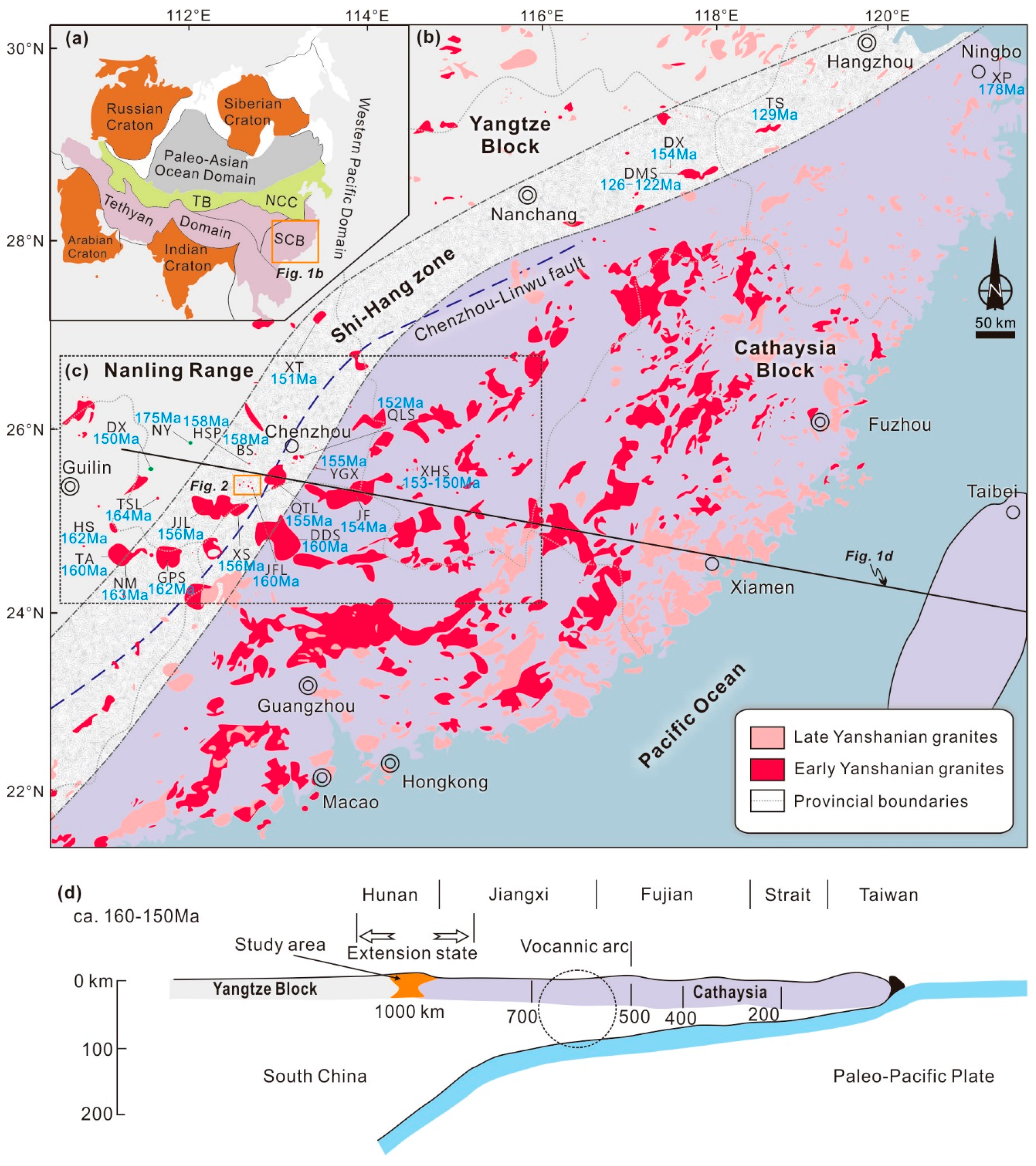
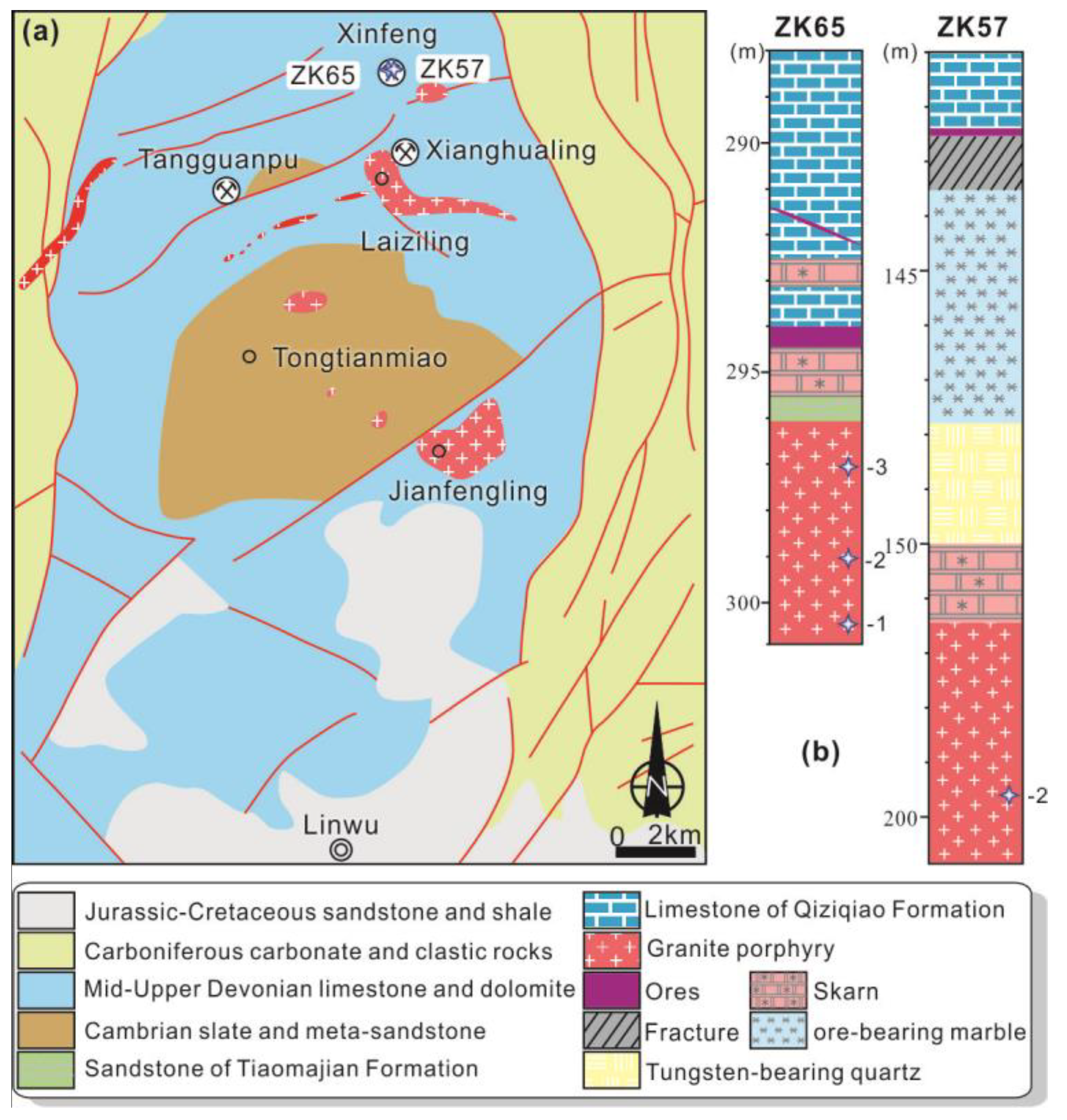
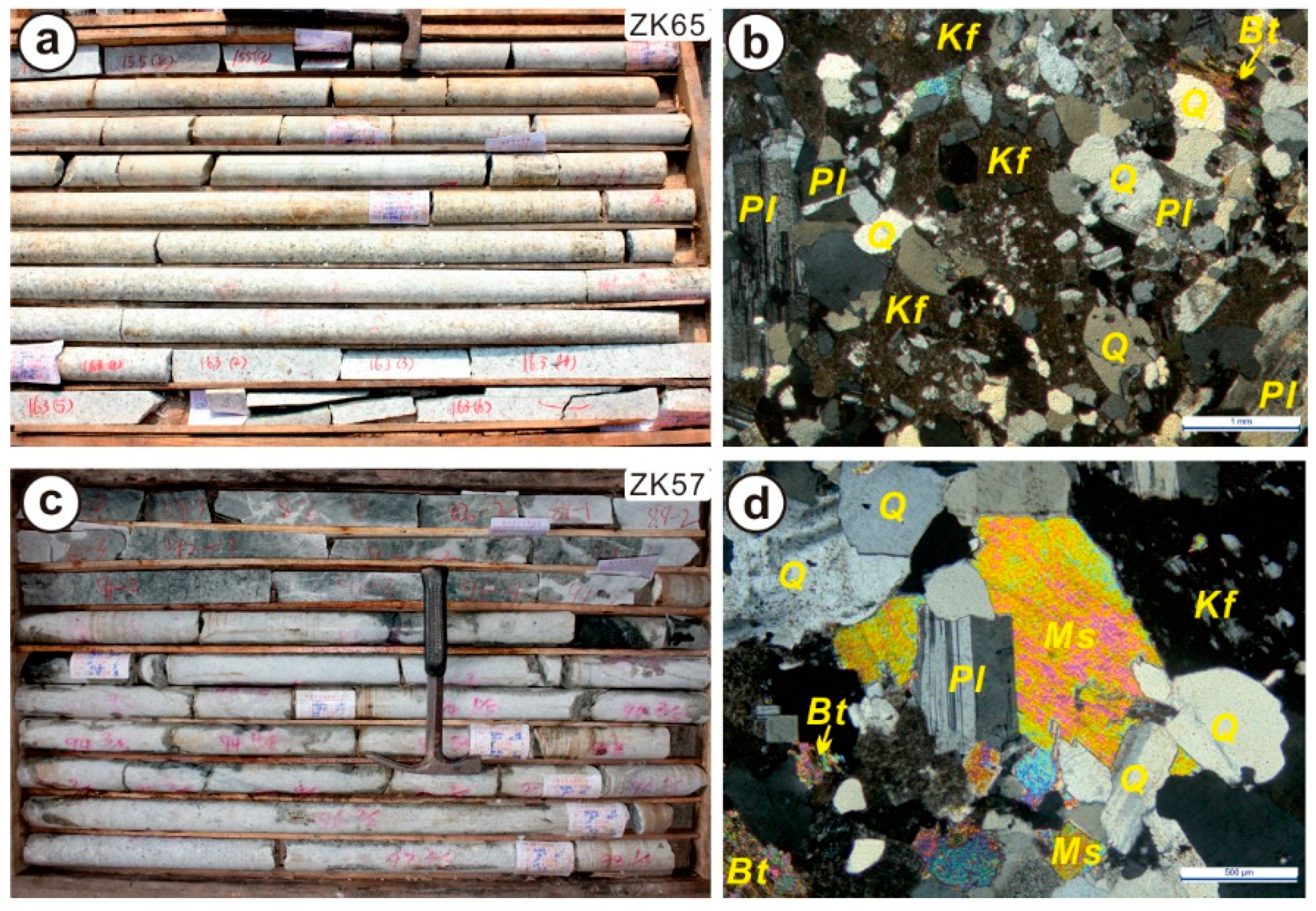
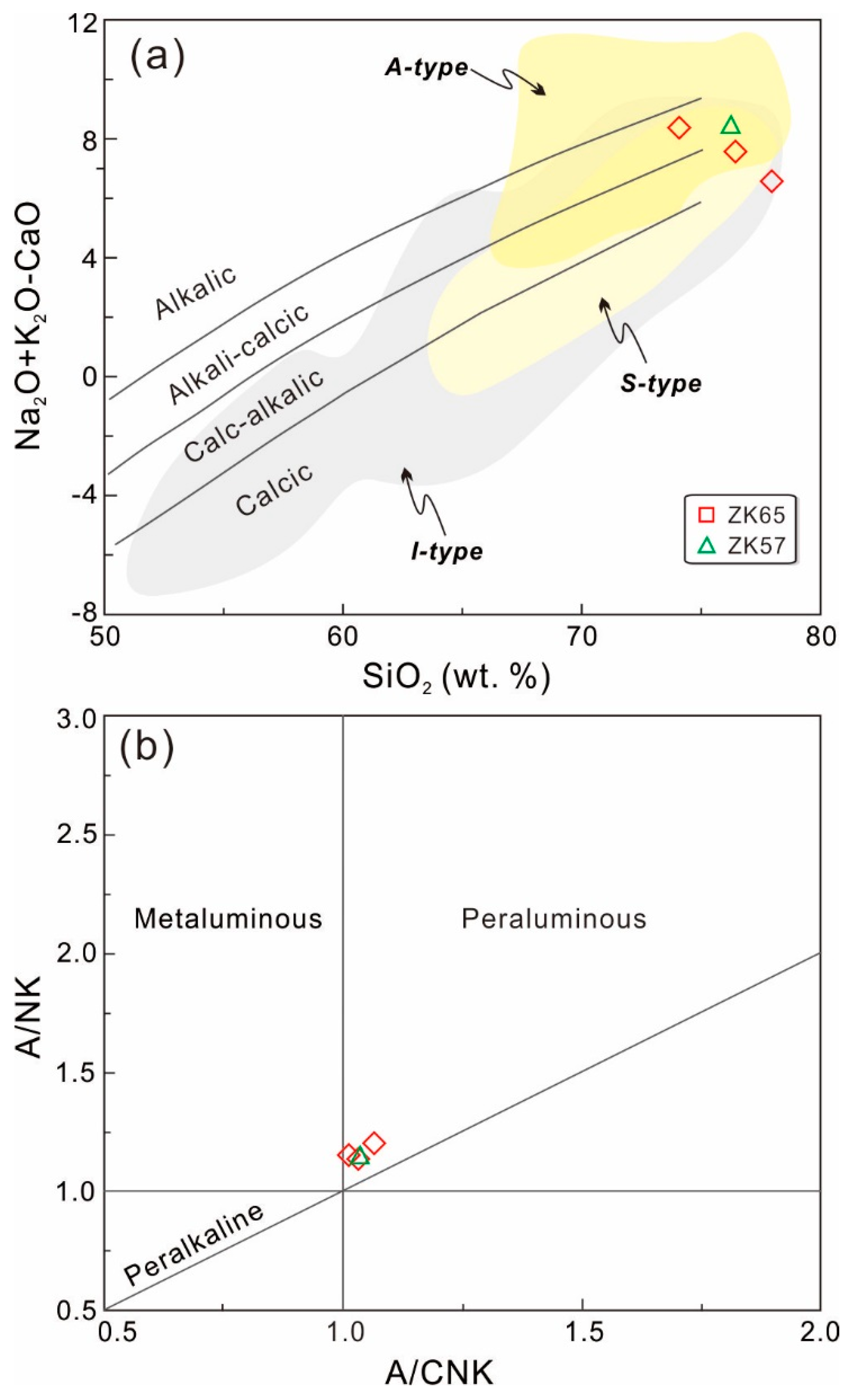
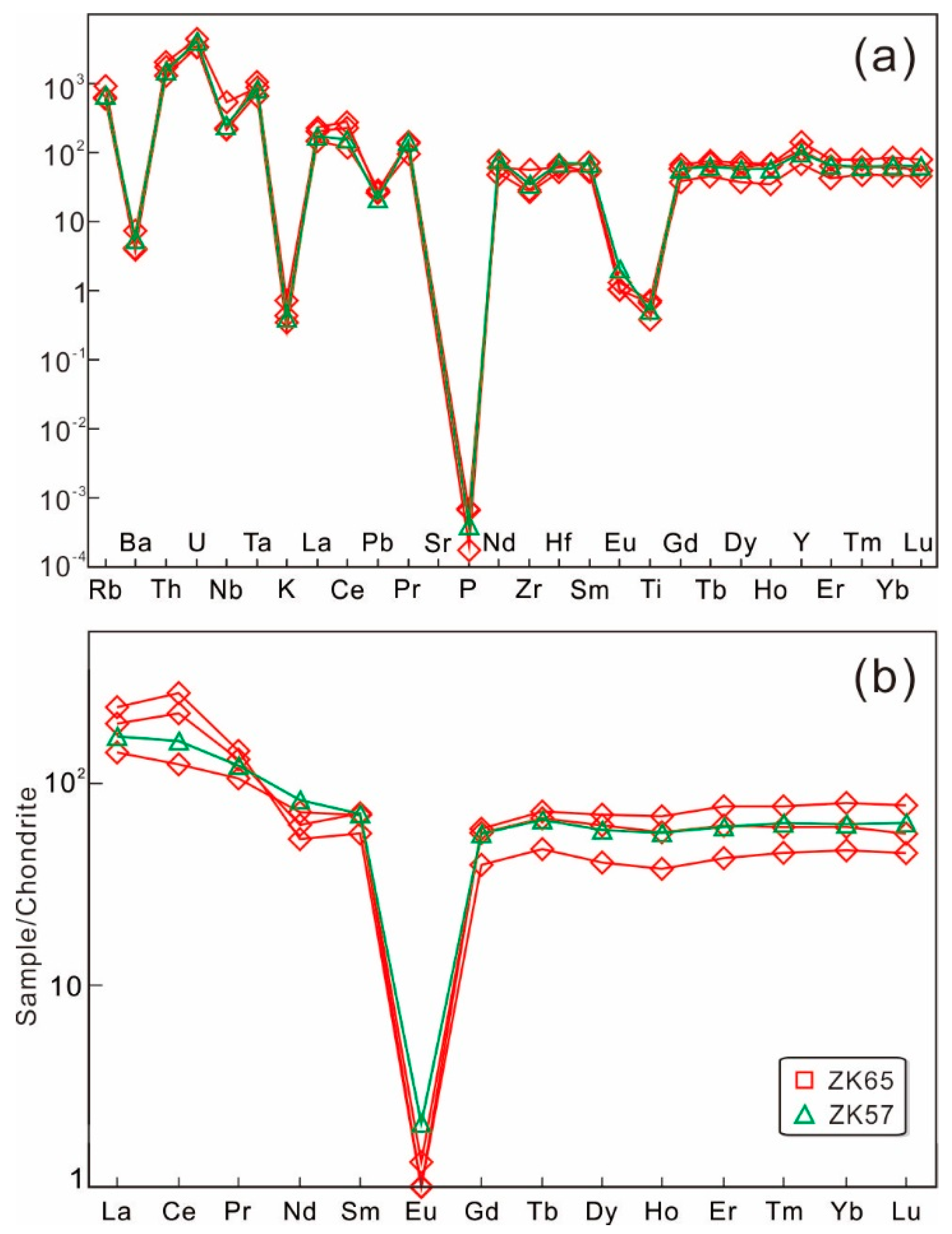
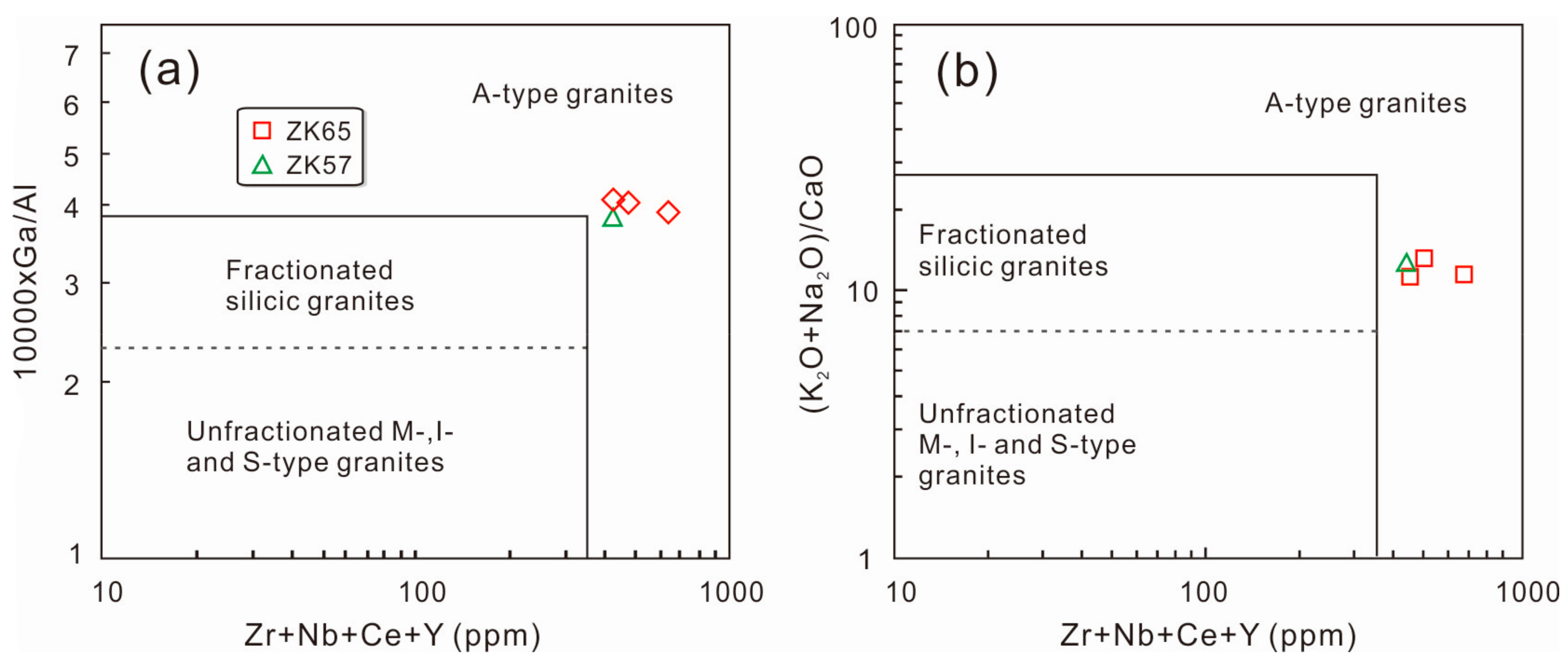
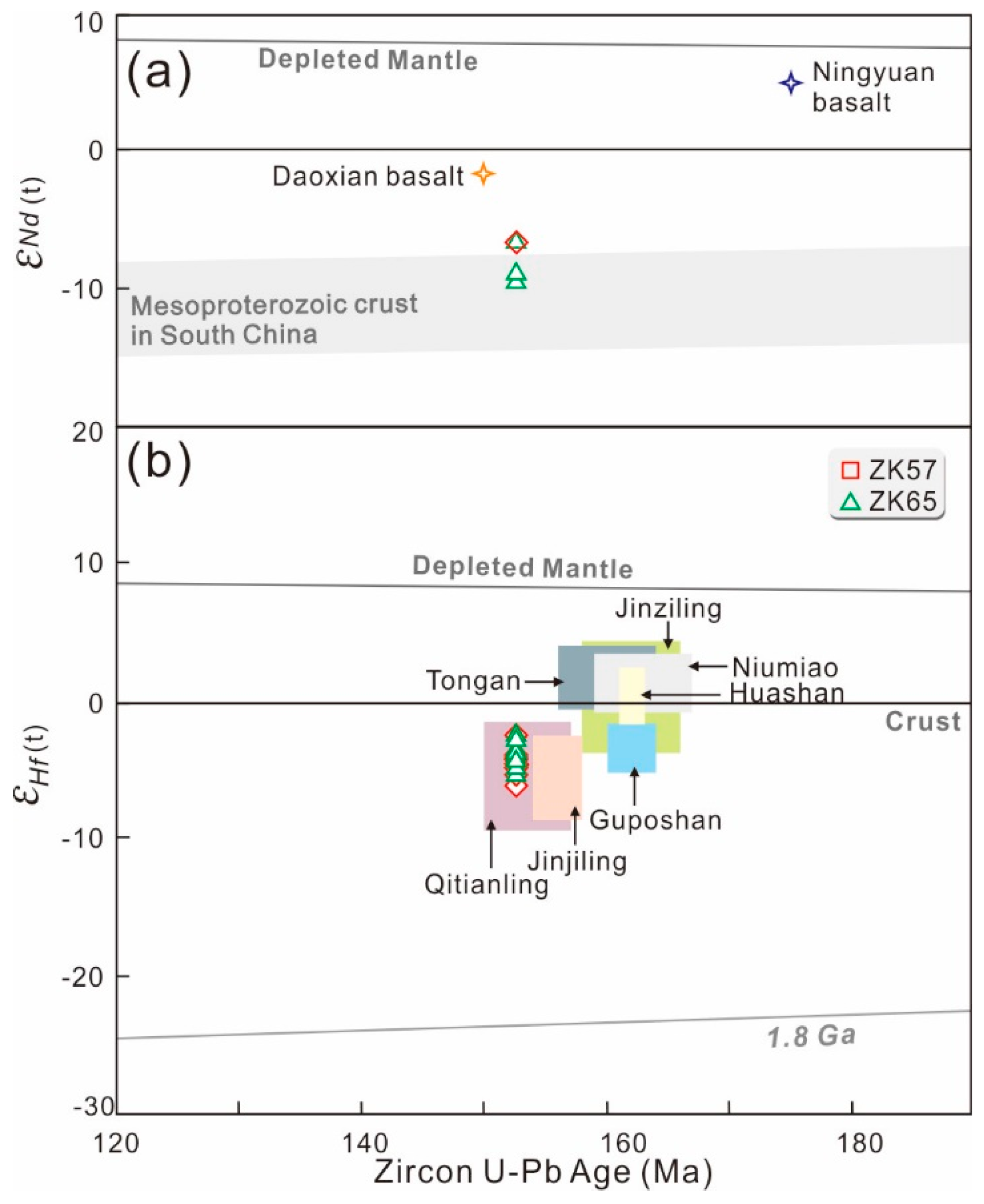
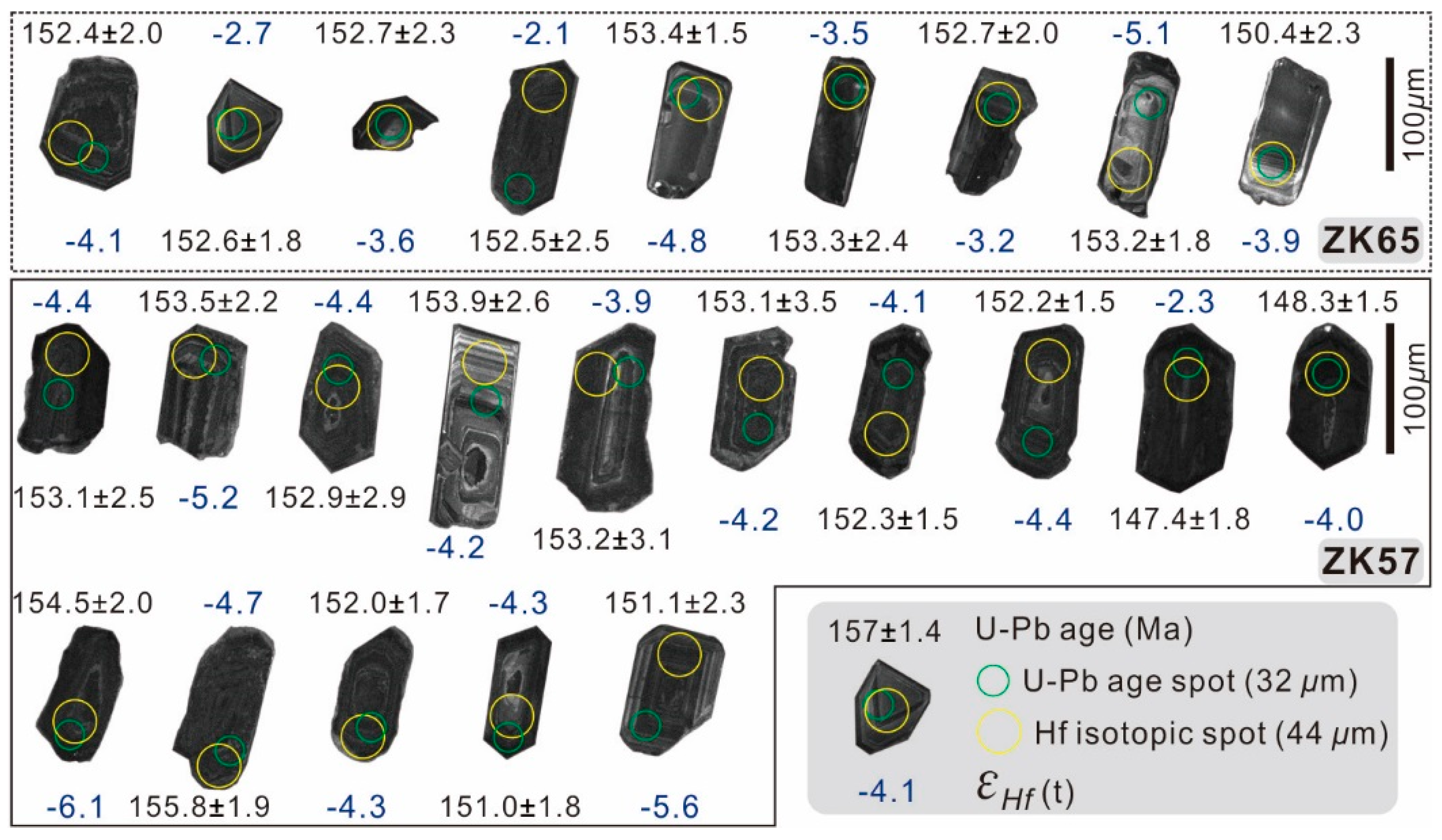
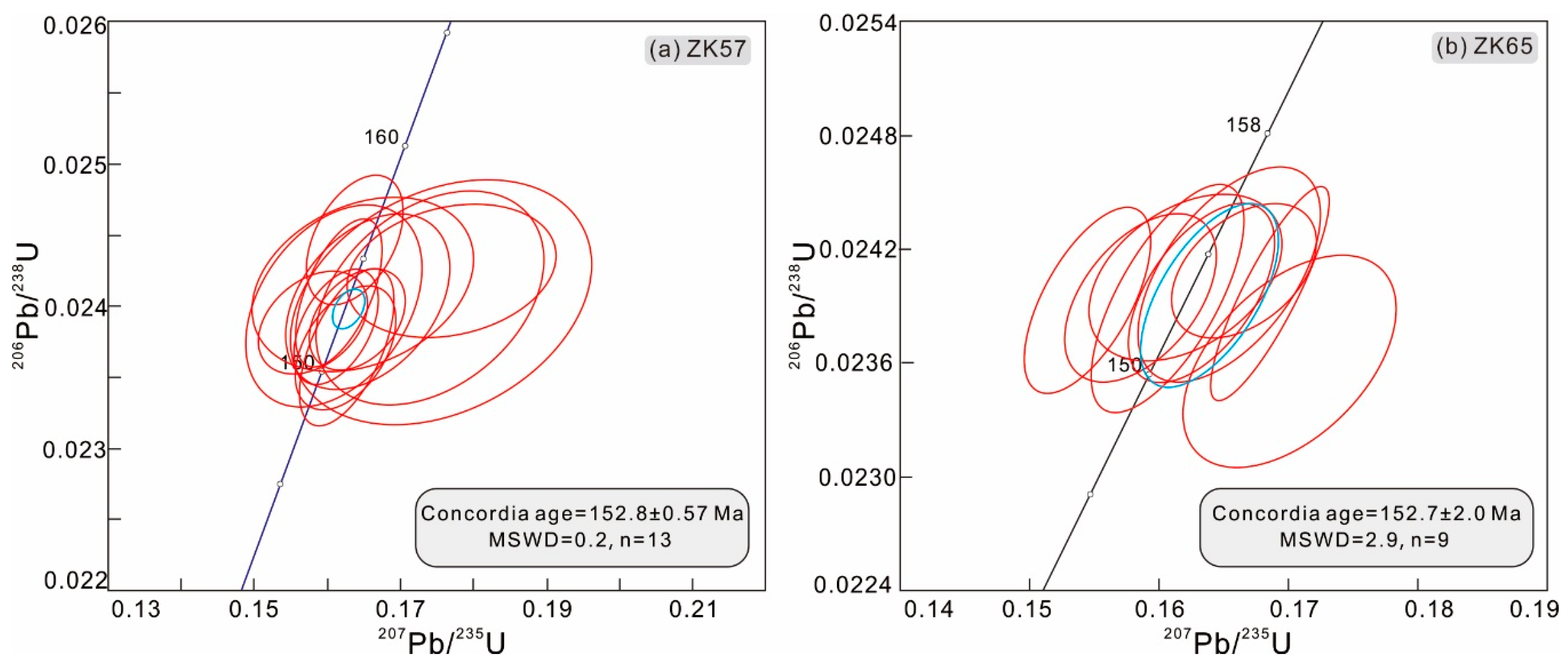
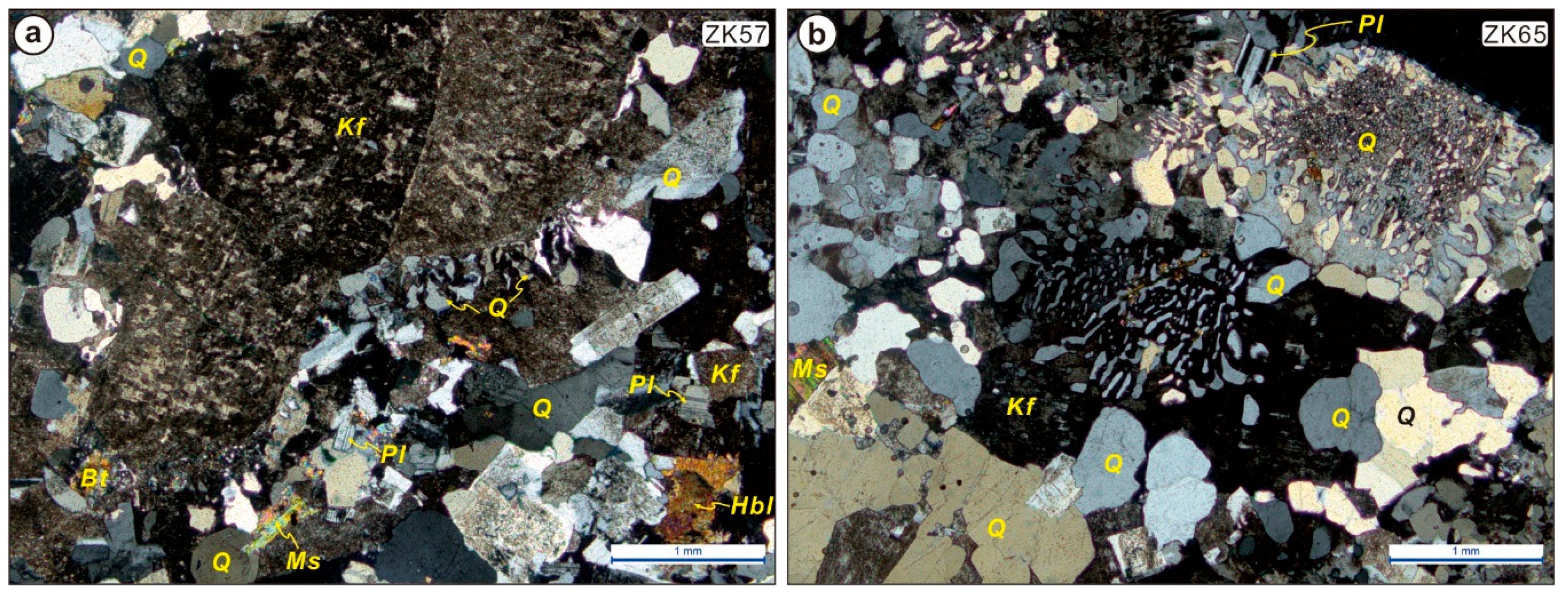
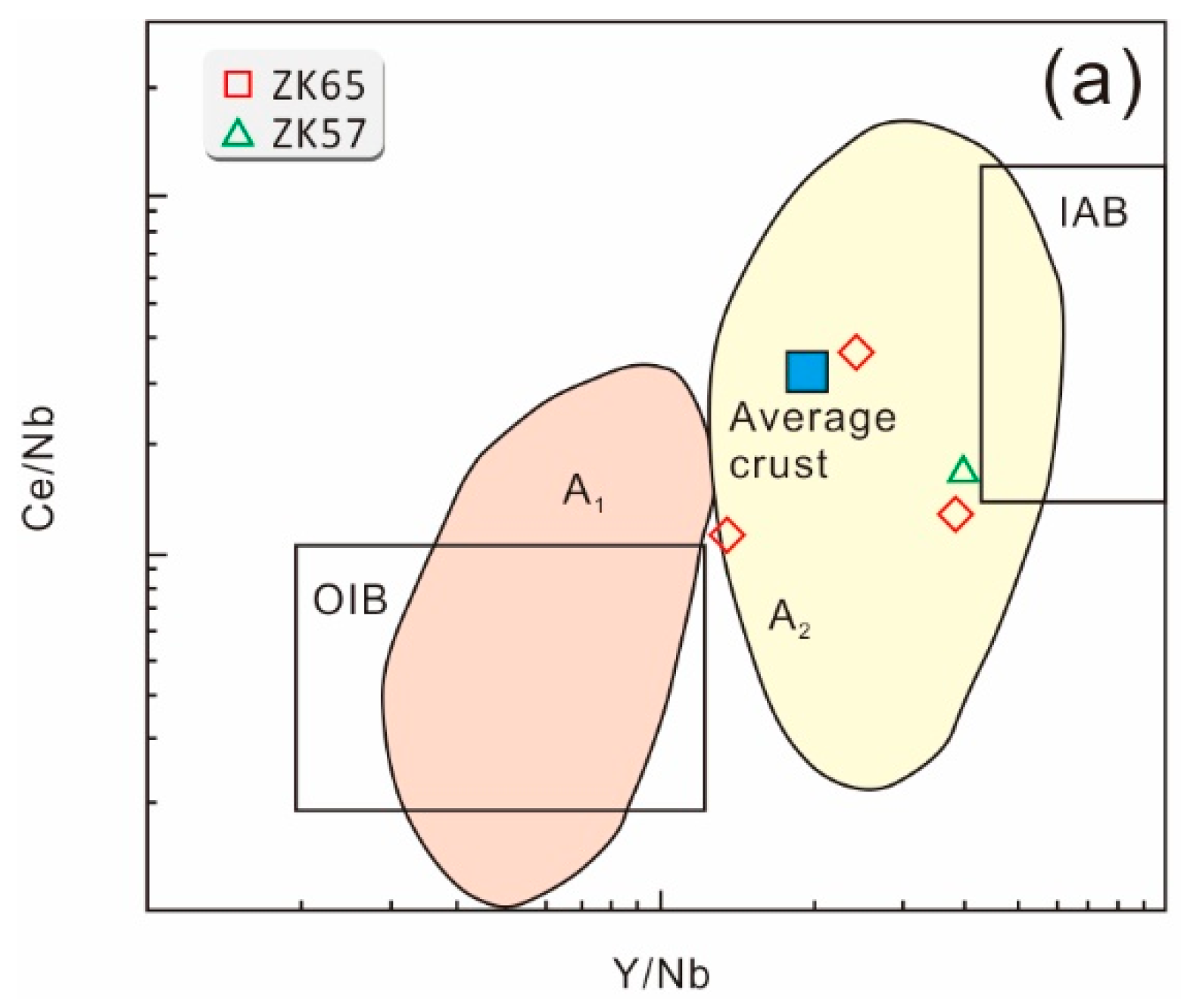
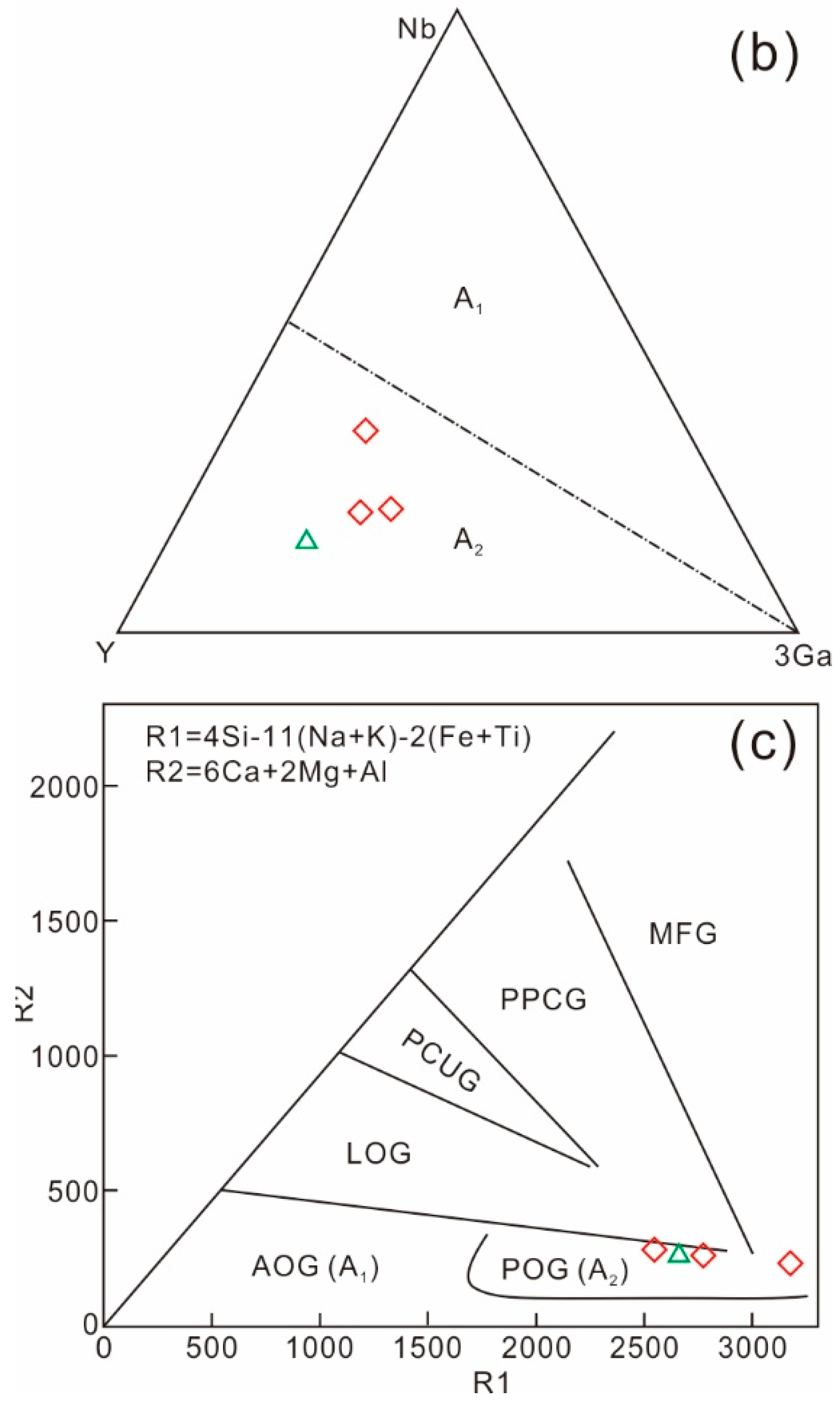
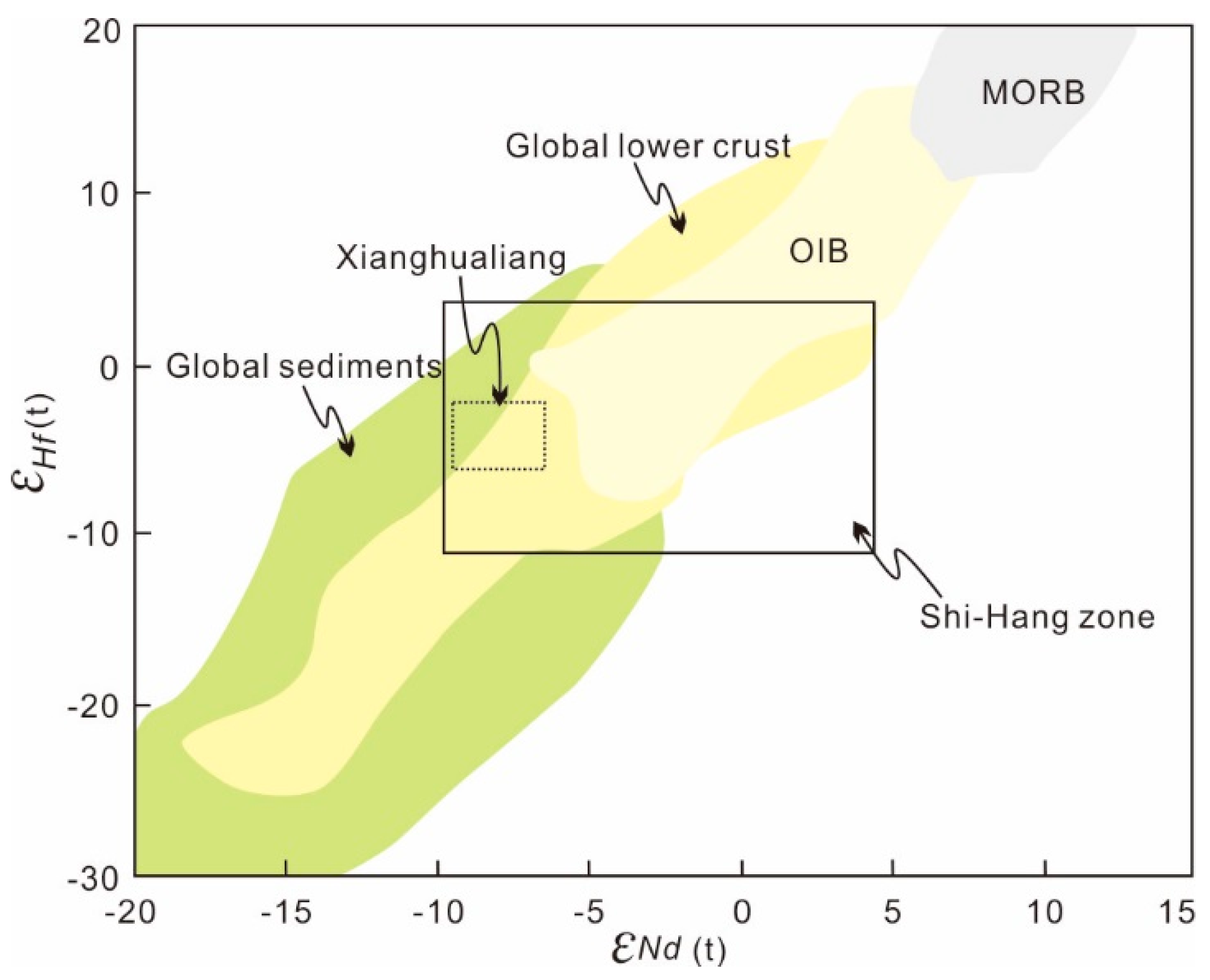
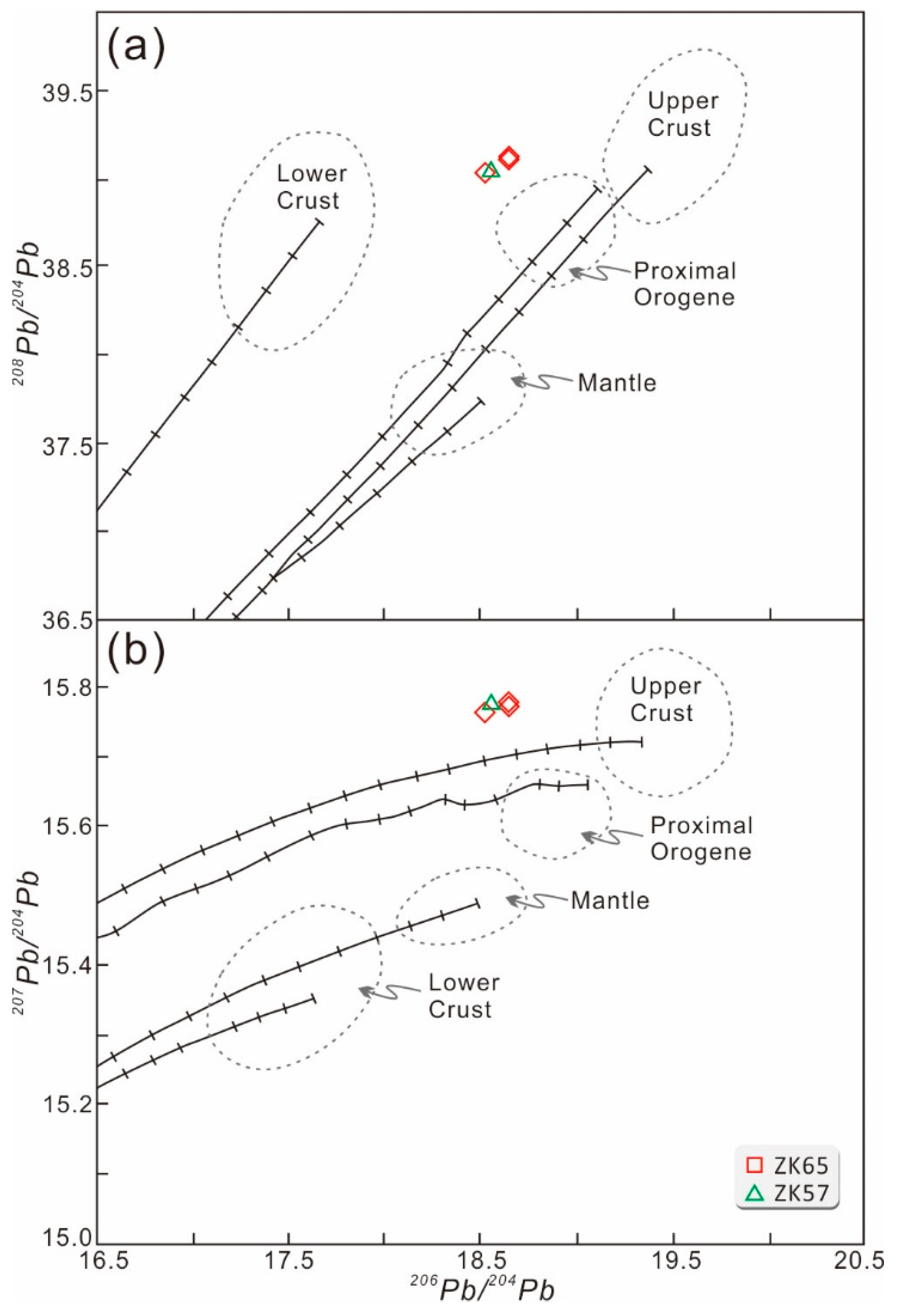
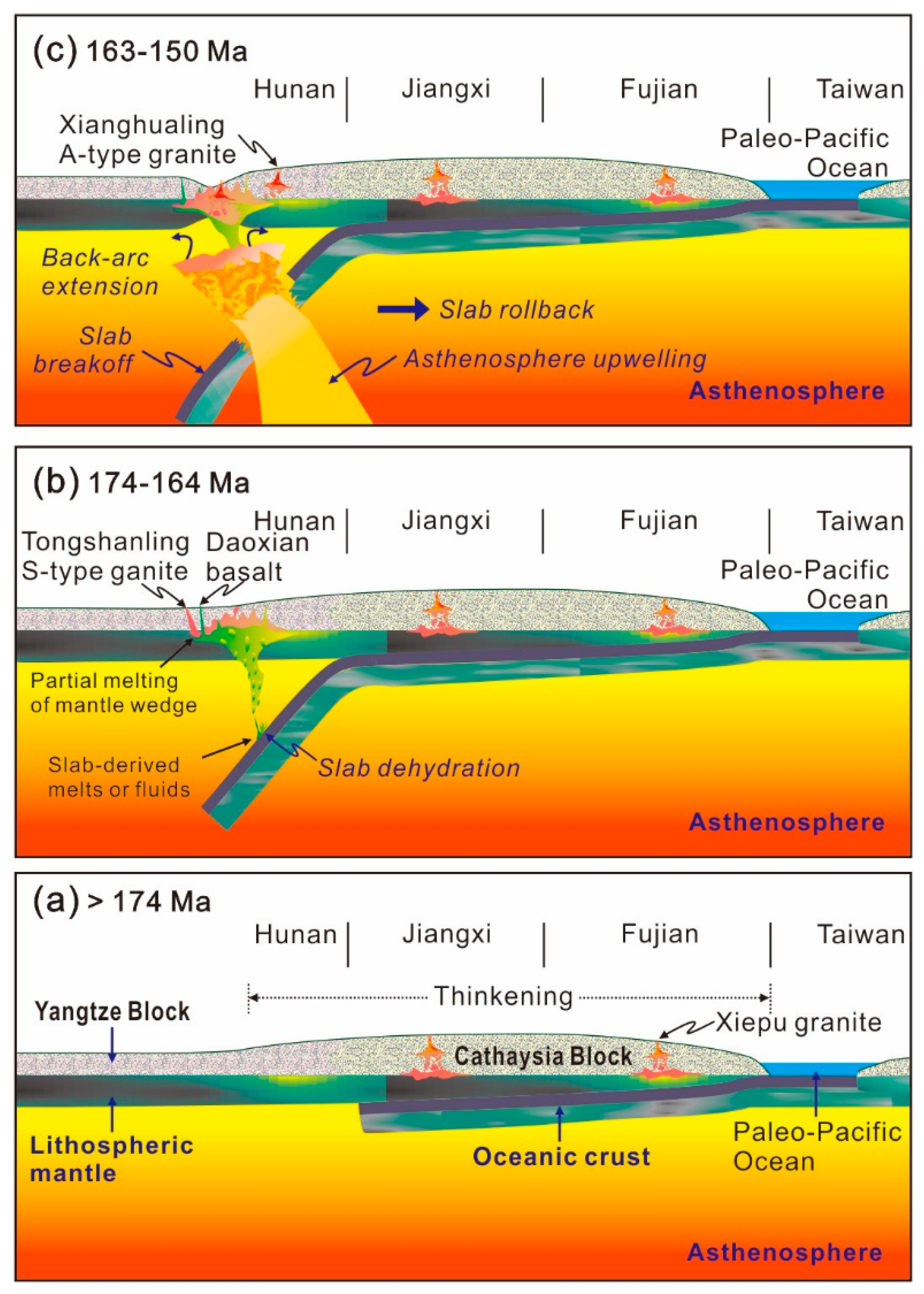
© 2019 by the authors. Licensee MDPI, Basel, Switzerland. This article is an open access article distributed under the terms and conditions of the Creative Commons Attribution (CC BY) license (http://creativecommons.org/licenses/by/4.0/).
Share and Cite
Xiao, C.; Shen, Y.; Wei, C. Petrogenesis of Low Sr and High Yb A-Type Granitoids in the Xianghualing Sn Polymetallic Deposit, South China: Constrains from Geochronology and Sr–Nd–Pb–Hf Isotopes. Minerals 2019, 9, 182. https://doi.org/10.3390/min9030182
Xiao C, Shen Y, Wei C. Petrogenesis of Low Sr and High Yb A-Type Granitoids in the Xianghualing Sn Polymetallic Deposit, South China: Constrains from Geochronology and Sr–Nd–Pb–Hf Isotopes. Minerals. 2019; 9(3):182. https://doi.org/10.3390/min9030182
Chicago/Turabian StyleXiao, ChangHao, YuKe Shen, and ChangShan Wei. 2019. "Petrogenesis of Low Sr and High Yb A-Type Granitoids in the Xianghualing Sn Polymetallic Deposit, South China: Constrains from Geochronology and Sr–Nd–Pb–Hf Isotopes" Minerals 9, no. 3: 182. https://doi.org/10.3390/min9030182
APA StyleXiao, C., Shen, Y., & Wei, C. (2019). Petrogenesis of Low Sr and High Yb A-Type Granitoids in the Xianghualing Sn Polymetallic Deposit, South China: Constrains from Geochronology and Sr–Nd–Pb–Hf Isotopes. Minerals, 9(3), 182. https://doi.org/10.3390/min9030182




